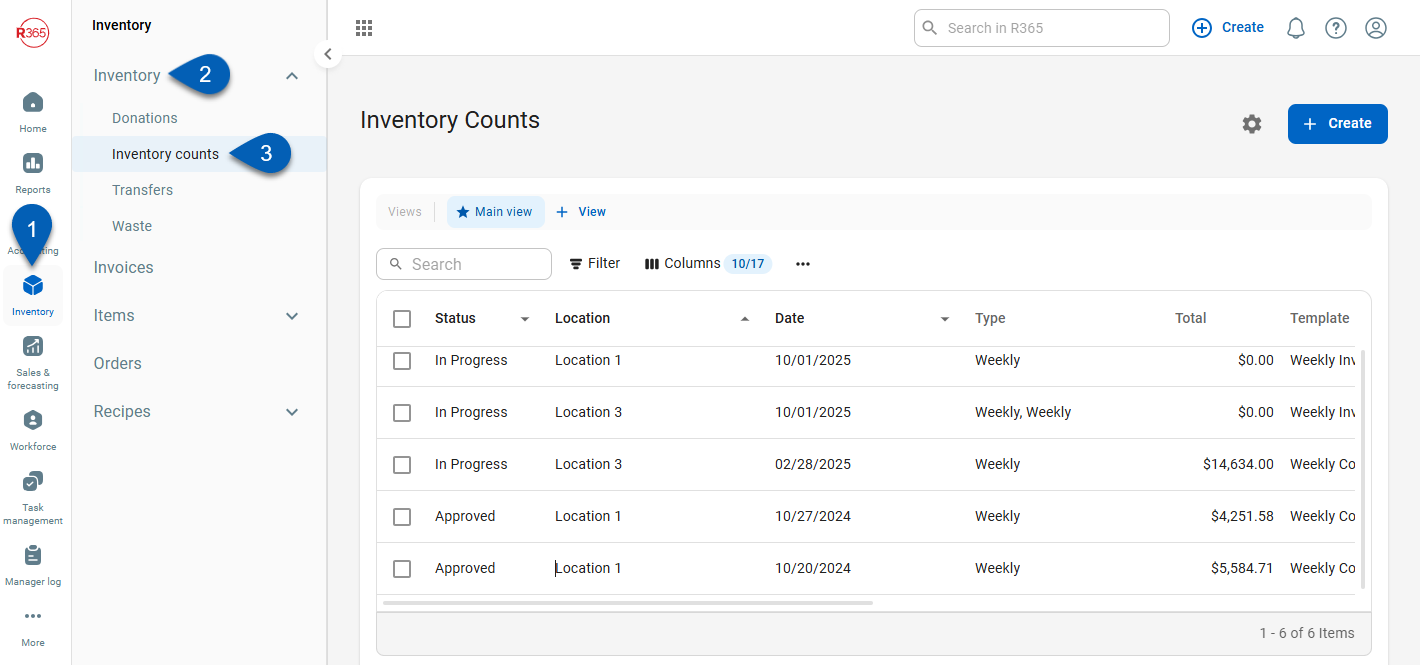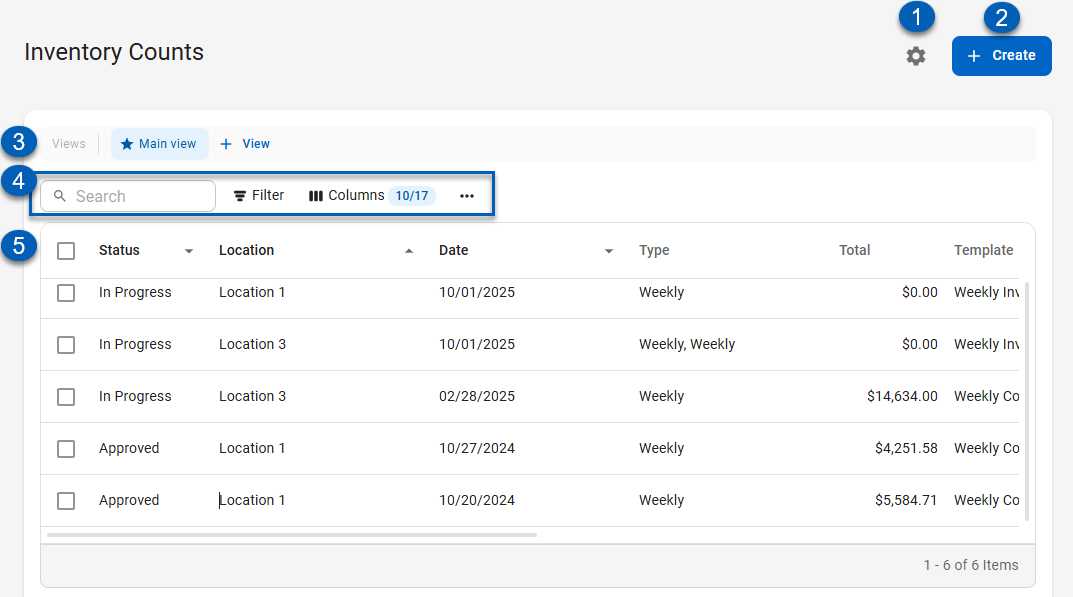This feature is in beta for select customers. Contact your CSM for more information.
Inventory Counts track the amount and value of items on hand at a specific time. In Restaurant365, the Inventory Counts feature gives restaurants an accurate, shelf-to-sheet view of their stock. It helps managers and staff verify quantities, reduce waste, and keep food costs under control.
When configured with Storage Locations and Inventory Templates, Inventory Counts follow the physical layout of a restaurant. This structure creates an efficient, consistent experience from shelf to sheet—helping teams complete counts faster and with greater accuracy. With shelf-to-sheet setup, staff count efficiently in the order items are stored, while managers gain accurate cost and usage data for decision-making.
From the Inventory Counts page:
Open existing counts for review and approval
Access the Inventory Count Settings page
Important Note on Updating Inventory Count Templates
Before updating an inventory count template, ensure that all counts using that template are completed and/or approved. If a template is edited while it is in use, then it will be updated to reflect the structure of the In Progress count when that count is marked as completed and/or approved.
Security
Inventory Count permissions are found in the permission tree as follows:
Food
Inventory Count Templates
View Inventory Count Templates
Edit Inventory Count Templates
Edit Inventory Template General Details
Edit Template GL Posting Status
Edit Template Count Schedule
Edit Items/Recipes
Add Items/Recipes
Remove Items/Recipes
Rearrange Items/Recipes
Create Inventory Count Templates
Delete Inventory Count Templates
Inventory Counts
View Inventory Counts
View Inventory Counts
View Count Distribution Tab
View Variance Tab
Edit Inventory Counts
Edit Inventory Counts
Edit Items/Recipes
Add Items/Recipes
Remove Items/Recipes
Create Inventory Counts
Unlock Inventory Counts
Approve Inventory Counts
Unapprove Inventory Counts
Delete Inventory Counts
Generate Using Theo on Hand
These permissions can be added to custom user roles or individual users. The Permission Access report can be used to determine which user roles or users already have these permissions assigned. For more information, see User Setup and Security.
Navigation
Navigation Steps
Open the Inventory app.
Expand Inventory.
Click Inventory Counts.

Search
Navigate to pages with the R365 global search bar:
Enter all or part of the page name in the R365 global search bar.
Select the page from the results list.
Only enabled pages can be searched for. If the desired page is not enabled, contact your CSM for assistance.

Inventory Counts Page

Button/Field | Description | |
|---|---|---|
1 | Inventory Count Settings | Opens the Inventory Count Settings. From the Inventory Count Settings, inventory templates can be viewed, created, and managed. Read more about new inventory templates. |
2 | Create | Starts a new inventory count. |
3 | Views | Saved table filters and column settings. The highlighted view is currently displayed. Click on a view to display the table with the saved filter and columns settings. Learn more about managing table views:
|
4 | Table Actions |
|
5 | Inventory Counts Table | Lists all created Inventory Counts and their details. Read about the column details below. |
Table Columns
Column | Description |
|---|---|
Status | The status of the inventory count. The status may be one of the following:
|
Location | The location that the count is associated with. |
Date | The date the count represents. This is the date selected upon creation of the inventory count. |
Type | Type of count that is used. This is determined by the type(s) of inventory templates used to create the count. If more than one template is used, the types will be separated by commas. |
Total | Total dollar amount for the items counted on the inventory count. This is based on the each amount of each item and the quantity of the items. |
Template | Name(s) of the template(s) used to conduct this inventory count. |
Theo Generated | Whether the count quantities were entered using the Generate Qty button on the inventory count. Read more about generating a count using theo on hand. |
GL Posting | Whether any of the items on the count were GL posting or not.
|
Completed By | User that marked the inventory count as complete. |
Completed On | Date and time that the inventory count was marked as complete. |
Created By | User that created the inventory count. |
Created On | Date and time that the inventory count was created. |
Modified By | User that last edited or made changes to the inventory count. |
Modified On | Date and time that the inventory count was last edited. |
Approved By | User that approved the inventory count (if the count has a status of Approved). |
Approved On | Date and time that the inventory count was approved (if the count has a status of Approved). |
Inventory Counts Setup
Before starting a count, set up the storage locations and inventory templates that organize items in the restaurant:
Storage Locations define where inventory is stored, such as Walk-In Cooler, Dry Storage, or Bar.
Inventory Templates determine which items appear on a count for a location and whether the count posts to the general ledger. Templates can be set to run on demand or on a schedule to ensure counts are completed regularly.
If GL posting is enabled on the template, the approved inventory count automatically updates the restaurant’s accounting records. The system calculates item distributions and posts them directly from the count.
GL posting settings are now controlled on the Inventory Template rather than on individual counts. Items linked to a posting template post automatically once the count is approved.
Setting these up in advance ensures the count mirrors the restaurant’s layout and supports a true shelf-to-sheet workflow.
Inventory Counts
To conduct a count, record the quantity of each item directly in the count sheet. Items sorting is determined by storage location setup, allowing staff to move through the restaurant in the same order they would physically check shelves.
Each entry is compared to the previous count. If an unusual change is detected, the system alerts users. These alerts help identify potential data entry errors or missing quantities before submission. Read more about creating and entering an inventory count.
Mobile Inventory Counts
Inventory Counts can also be completed in R365 Mobile using a phone or tablet. Read more about mobile inventory counts.
When using a mobile device, barcode scanning makes it faster to locate and count items directly from the shelf, ensuring accuracy and saving time during busy inventory periods. Read more about barcode scanning for inventory counts.
Review and Approve Counts
Once all items are entered, the count moves into Review. In this step, verify quantities, resolve alerts, and adjust variances as needed. Once verified, the count can be completed and/or approved. Approval finalizes the count and records it for accounting and reporting.
Learn more about reviewing and approving counts.

